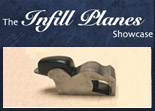Wooden Bench Plane Basics
…planes and how to use them. It identifies the main types – smooth planes, jack planes, fore planes and jointers – and in what situations they’re best suited to. It also includes some information on plane blades and how they work. Planes and Plane-like Tools The plan and the section, Fig. 84, show a smooth plane. The stock a, when of wood, is usually beech. In it is an opening, or “throat”, b, which receives the iron c>; this is held in place by t…





